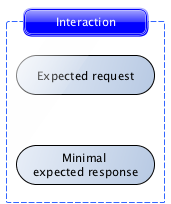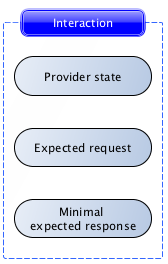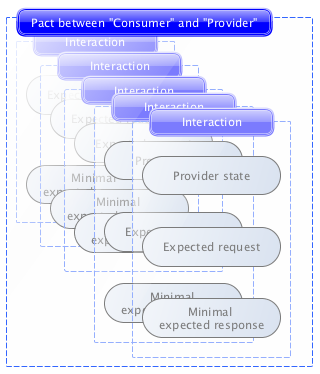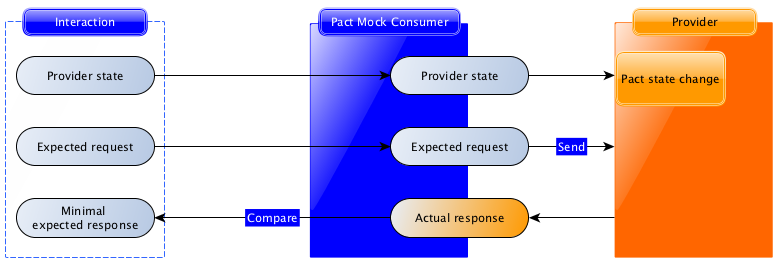How Pact works
Remember these definitions from the introduction:
- Consumer: An application that makes use of the functionality or data from another application to do its job. For applications that use HTTP, the consumer is always the application that initiates the HTTP request (eg. the web front end), regardless of the direction of data flow. For applications that use queues, the consumer is the application that reads the message from the queue.
- Provider: An application (often called a service) that provides functionality or data for other applications to use, often via an API. For applications that use HTTP, the provider is the application that returns the response. For applications that use queues, the provider (also called producer) is the application that writes the messages to the queue.
A contract between a consumer and provider is called a pact. Each pact is a collection of interactions. Each interaction describes:
- For HTTP:
- An expected request - describing what the consumer is expected to send to the provider
- A minimal expected response - describing the parts of the response the consumer wants the provider to return.
- For messages:
- The minimal expected message - describing the parts of the message that the consumer wants to use.

The first step in writing a pact test is to describe this interaction.
Consumer testing
Consumer Pact tests operate on each interaction described earlier to say "assuming the provider returns the expected response for this request, does the consumer code correctly generate the request and handle the expected response?".
Each interaction is tested using the Pact framework, driven by the unit test framework inside the consumer codebase:
Following the diagram:

- Using the Pact DSL, the expected request and response are registered with the mock service.
- The consumer test code fires a real request to a mock provider (created by the Pact framework).
- The mock provider compares the actual request with the expected request, and emits the expected response if the comparison is successful.
- The consumer test code confirms that the response was correctly understood
Pact tests are only successful if each step completes without error.
Usually, the interaction definition and consumer test are written together, such as this example from this Pact walkthrough guide:
Although there is conceptually a lot going on in a pact interaction test, the actual test code is very straightforward. This is a major selling point of Pact.
In Pact, each interaction is considered to be independent. This means that each test only tests one interaction. If you need to describe interactions that depend on pre-existing state, you can use provider states to do it. Provider states allow you describe the preconditions on the provider required to generate the expected response - for example, the existence of specific user data. This is explained further in the provider verification section below.

Instead of writing a test that says “create user 123, then log in”, you would write two separate interactions - one that says “create user 123”, and one with provider state “user 123 exists” that says “log in as user 123”.
Once all of the interactions have been tested on the consumer side, the Pact framework generates a pact file, which describes each interaction:

This pact file can be used to verify that the provider meets the consumer's expectations.
Provider verification
In contrast to the consumer tests, provider verification is entirely driven by the Pact framework:

In provider verification, each request is sent to the provider, and the actual response it generates is compared with the minimal expected response described in the consumer test.
Provider verification passes if each request generates a response that contains at least the data described in the minimal expected response.
In many cases, your provider will need to be in a particular state (such as "user 123 is logged in", or "customer 456 has an invoice #678"). The Pact framework supports this by letting you set up the data described by the provider state before the interaction is replayed:

Putting it all together
Here’s a repeat of the two diagrams above:

If we pair the consumer test and provider verification process for each interaction, the contract between the consumer and provider is fully tested without having to spin up the services together.
Next steps
Contract tests should focus on the messages (requests and responses) rather than the behaviour. It can be tempting to use contract tests to write general functional tests for the provider. Experience shows this to leads to painful experiences with brittle tests. See this guide for contract testing best practices.
Pact tests should be data independent. Pact tests are best when successful verification doesn’t depend on the specific data that the provider returns. See this guide for best practices when describing interactions.
Use the broker to integrate Pact with your CI infrastructure. Integrating Pact with your continuous integration infrastructure is a major win for safe and successful deployment. See this guide for Pact integration best practices